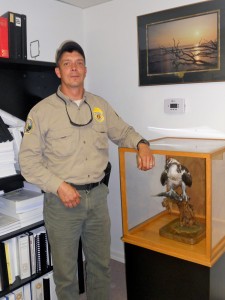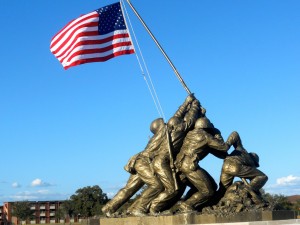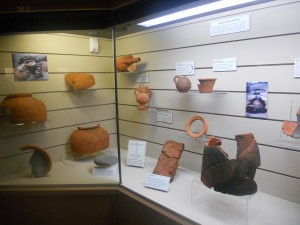Preserving the natural resources at Parris Island: Van A. Horton
Parris Island is truly one of Beaufort County’s truly pristine pieces of Lowcountry land and obviously, it needs the oversight of a skilled individual that knows how to maintain and protect its precious resources.
Federal Game Warden, Van A. Horton has been brought on board to be caretaker of this great Natural Resource, Marine Corps Recruit Depot in Port Royal, South Carolina. He is the Conservation Law Enforcement Officer on base. Van is originally from Hampton, S.C., where he grew up playing outdoors, however, he has spent most of his life right here in good ole Beaufort. He and his beautiful wife, Judy have three boys: John Paul, Jacob, and Samuel.
Parris Island is a pretty good size piece of land consisting of 8,095 acres, 19.6 square miles (12.2 land 7.4 water). For thousands of years, Native Americans lived on the island, but it was unoccupied in May 1562, when two French ships arrived. Their leader, Jean Ribaut, named the harbour “Port Royal” and built Charlesfort. The garrison of about 30 men abandoned the fort in 1563. Pedro Menéndez de Avilés arrived in January 1566 to establish the Spanish colony of Santa Elena over the ruins of Charlesfort. By 1569, over 200 colonists were on Parris Island. In 1576, warfare with neighboring Indians forced a withdrawal, but in 1577, the Spanish returned and within a few years Santa Elena was home to some 400 residents. Serving for a period as the capital of all La Florida, Spain abandoned Santa Elena in 1587, but maintained contact with Native Americans who reoccupied the island through the 1600s.
In 1715, Alexander Parris purchased the island that now bears his name. By the 1720s, British plantations thrived on Parris Island. Slaves, the majority population, worked the land continuously until the fall of 1861 when Union forces occupied the region. Parris Island’s former slaves were trained and educated by missionaries, such as the well-known abolitionists Frances Gage, and began independent, free lives.
Through the efforts of local politicians, including Congressman and former slave Robert Smalls, in 1882 a naval station was established on Parris Island. In 1891, Marines arrived to provide security for the naval station. In 1909, command of the installation fell to a Marine Corps Lieutenant Colonel who oversaw an officer’s training school and for a brief period in 1910, a recruit depot. Later, the  island transformed into a naval Disciplinary Barracks. In 1915, Parris Island was turned over entirely to the Marine Corps and since that date, the primary mission has remained focused on making new Marines. The long history of Parris Island has left a rich cultural legacy and today MCRDPI is custodian to many unique cultural resources. Along with more than 100 archaeological sites, the island, affectionately called the “Cradle of the Corps,” also contains a diverse historic military landscape chronicling the development of the Marine Corps from the late 19th century to today’s modern Marine warrior.
island transformed into a naval Disciplinary Barracks. In 1915, Parris Island was turned over entirely to the Marine Corps and since that date, the primary mission has remained focused on making new Marines. The long history of Parris Island has left a rich cultural legacy and today MCRDPI is custodian to many unique cultural resources. Along with more than 100 archaeological sites, the island, affectionately called the “Cradle of the Corps,” also contains a diverse historic military landscape chronicling the development of the Marine Corps from the late 19th century to today’s modern Marine warrior.
USMC Master Sergeant Retired, Warren Disbrow and I recently paid a visit to Van on Parris Island, of which he takes great pride in protecting and preserving its natural and cultural resources. This part time farm-boy, graduated from The Citadel with a degree in biology, which comes in pretty handy with his current position. After doing some odd jobs as many of us DUDES have done, Van served with the Coast Guard down in Brunswick, Georgia. After that, he was a South Carolina Department of Natural Resources officer for 14 years, stationed right here in Beaufort County out of the Waddell Mariculture Center run by Al Stokes. His current boss, John Holloway is also a by-product of SCDNR and the Waddell Mariculture Center. Together, they see to all the necessary things that need to be done to protect and maintain the natural and cultural resources on Parris Island. They also informed me that all military bases have departments dedicated to the Natural Resources of each particular property or installation.
Van is responsible for the “Foot Print” of Parris Island and that includes all the natural resources and environmental affairs. John and Van’s efforts come from the G-4, the Installation and Logistics Department and nothing they or their colleagues do is without the approval and directive from Depot Commanding General, Brigadier General Lori Reynolds. Sure, this includes taking care of the wildlife, however it may include some things you wouldn’t initially think about, such as, monitoring building construction, so it does not adversely affect water quality, endangered and threatened species and wetlands. If construction projects do have unavoidable impacts to these resources, then they must be mitigated and approved by Federal and State entities.
First let’s take a look at the protection and preservation of the wildlife on Parris Island. Making sure that storm water run-off is managed properly is very important to maintaining proper salinity levels that are key to the oysters, clams, shrimp, crabs and whelks that taste so delicious and inhabit this area. Parris Island has some fresh and salt water fishing that is simply off the charts. These waters can be fished by Properly Saltwater Fishing Licensed active duty, active duty dependents, retired military and Department of Defense employees. Van makes sure these lucky individuals are playing by the rules and are adhering to SCDNR rules and regulations, such as size and bag limits. There are also a lot of rattlesnakes on Parris Island DUDE!
The Natural Resources Section is currently working with scientists as they are doing an ongoing Eastern Diamondback study on Parris Island. They have placed tracking chips in some Eastern Diamondbacks, so they can map their movements and record their growth rates. I found it interesting that Van said all of the rattlesnakes on Parris Island are Eastern Diamondbacks, where the majority of rattlesnakes on the Marine Corps Air Station are Canebrakes. He figured that the Eastern Diamondback’s ability to swim much better than the Canebrakes may figure in to the reasoning of this oddity.
There are birds of prey such as owls, osprey, hawks and bald eagles that thrive on the two bases that must be protected. It was interesting to hear that there are two couples of bald eagles living and thriving on Parris Island and that’s great to hear with all the ubiquitous gun fire being done during training. Van shared an amazing story of watching an osprey who had just plucked a mullet from the water, all to be dive bombed by one of the bald eagles, knocking the osprey looney and stealing its dinner. Sure would be cool to have a photo of that DUDE!
Of course Parris Island has its fair share of critters such as; Squirrels, Raccoons, Opossum, Otters and Gators that pretty much take care of themselves, however the white-tail deer population requires a bit more attention. For a few years Parris Island did not have a Federal Game Warden to oversee the depredation of the deer population and this allowed the population to get well above the desired level. According to Van, the preferable deer to land ratio is 1 deer per 10 acres. The desirable population of deer should be somewhere near 350 on the island and this past deer season, Van, “Diz” and a few fortunate hunters did some regulated herd controlling hunts that bagged roughly 100 deer. If deer are allowed to over populate due to having no natural predators, they can get emaciated and become starving disease ridden deer, yielding a very unhealthy population of deer like some no kill plantations in our area. They have roughly 85 applicants to partake in these hunts and there are 20 or so lucky ones that get drawn out of the hat for each hunt. Many are active  and retired military that may not have the opportunity to hunt elsewhere. Others are from the Parris Island Rod and Gun Club and they harvest these deer, donating the meat to worthy groups, as well as cutting out the jawbones for SCDNR records, aging the deer that have been taken and providing other information to better understand the health of the herd. There is a lot of work that goes on year round to maintain the white-tails such as; maintaining stands, tending to feeders, retrieving photos from trail cameras, etc. Van spends many nights in the summer spotlighting the deer to get a good handle on population numbers. This helps him decide how many deer should be harvested. Much care is paid to which deer to shoot, such as does that are hopefully not lactating and bucks that are at least 7 or 8 points with racks outside the ears.
and retired military that may not have the opportunity to hunt elsewhere. Others are from the Parris Island Rod and Gun Club and they harvest these deer, donating the meat to worthy groups, as well as cutting out the jawbones for SCDNR records, aging the deer that have been taken and providing other information to better understand the health of the herd. There is a lot of work that goes on year round to maintain the white-tails such as; maintaining stands, tending to feeders, retrieving photos from trail cameras, etc. Van spends many nights in the summer spotlighting the deer to get a good handle on population numbers. This helps him decide how many deer should be harvested. Much care is paid to which deer to shoot, such as does that are hopefully not lactating and bucks that are at least 7 or 8 points with racks outside the ears.
Taking care of the plants, fauna and trees are also a big part of what Van oversees. Battling invasive species such as the ChineseTallow Tree, also known as the Popcorn Tree are important as they get so dense, that the wildlife cannot navigate through them and they can choke out other various native plants. Those trees were brought over from China, as the fruit was used to make a particular type of soap. There are other invasive non-indigenous trees such as; mimosa, chinaberry and salt cedar that must be taken care of via the spraying of herbicides. Van works with Clemson University to assist him in the managing of the plants and trees. They help recommend the correct herbicides and can do various tests regarding fungi and diseases that may be affecting the plants on base. I found it interesting that Van and company actually oversee timber harvesting on the island. In 2011 they cut and harvested a good size track of pine trees mainly for density reasons. It was nice to hear that they got to keep the money generated from this sale to buy equipment (bush-hogs, bobcat tractors, etc.) that help them maintain the property. I asked Van, “What did you do with all those stumps DUDE?” Well, it seems that, “Marines helping Marines” works in many different ways, as the Marines from the Marine Corps Air Station sent over a couple bulldozers. They uprooted them and piled them up for disposal. Van is currently working on rehabilitating that tract of land as the dense forest of pines had the pH levels very low. Through a few years of introducing some lime to correct those levels, he hopes that the land will be healthier and thus more plantable.
It’s nice to see someone doing what they truly love and I could tell Van loves what he’s doing by protecting and maintaining the Natural Resources of Parris Island. I would like to thank the Marine Corps on Parris Island for allowing us to visit the base and spend a few hours with Van to find out more about him and all the great work he and John are doing for Parris Island.
A BIG OOORAH DUDES! KEEP UP THE GREAT WORK!
For more from DUDE Magazine, visit www.dudesc.com and make sure you go and give them a ‘Like’ on Facebook too!
Story originally published by Brad McDonald & DUDE Magazine






